High resource prices have brought a boost to Saskatchewan’s revenues, resulting in a surplus budget and allowing for reduction of the provincial debt as well as relief measures for residents struggling under the high cost of living.
According to the Ministry of Finance, the higher revenue from non-renewable resources means Saskatchewan is now forecasting a surplus of $1.04 billion for the first quarter, which is $1.51 billion higher than predicted in the budget.
Finance Minister Donna Harpauer said during a media conference Tuesday that the province’s budgetary stance has changed due to the influx of revenue. In March, the government forecast a $463-million deficit.
“It is a huge moment that it’s not only balanced but it’s balanced so strongly,” she said. “However, I will still be very concerned as I enter into the deliberations for the next budget that we cannot assume that prices will stay this high.
“We cannot get caught up in the volatility of resource revenues and so we still will have to be very, very, very careful in our spending going forward.”
Harpauer warned that if resource prices fall, the government will still need a base revenue so it can deliver services to the people of the province. If the prices increase, Harpauer said decisions on how to spend the windfall will be made at that time.
Revenue from non-renewable resources increased by $1.86 billion, the finance ministry said, reflecting higher prices for oil and potash.
Asked why the government’s projections for resource revenues weren’t this high when the budget was delivered in March, Harpauer said the government relies on projections from the industry.
The impact of the Russia-Ukraine war and a shortage of supply have driven up resource prices.
Income from taxes was also up by more than $500 million, which the provincial government credited to a stronger-than-expected economic recovery after the COVID-19 pandemic.
With the province expecting revenue of $19.17 billion — more than $2 billion higher than predicted in the budget — Harpauer said Saskatchewan’s strong economy “is poised to lead the provinces in economic growth in 2022.”
Expenses are expected to total $18.13 billion, the government noted, which is more than a half-billion dollars higher than budgeted.
The big increase in money going out is largely due to an expenditure of about $450 million, which will provide every adult in the province with a $500 relief cheque this fall.
Public debt, the Ministry of Finance added, is forecast to be $1.72 billion lower than budgeted, with the surplus allowing the province to “retire up to $1 billion in existing debt.”
Saskatchewan’s real GDP is expected to grow by 4.7 per cent in 2022 and 2.5 per cent in 2023, the ministry added.
“Our economy is strong and growing,” Harpauer said.
On Tuesday, the provincial government also announced a four-point affordability plan, aiming to help with the rising cost of living through the coming relief cheques, PST adjustments, a reduction in the small business tax rate, and overall reduction of the provincial debt.
Harpauer admitted that economists will say dumping money into the system via the relief cheques will drive up inflation, but she doesn’t believe that will happen in this case.
“This will be one time and not ongoing and, again, with the resource revenues belonging (to the people), we do believe that the people should benefit from strong resource revenues,” she said. “Do I believe that this one-time injection will skew inflation long term? I do not.”







